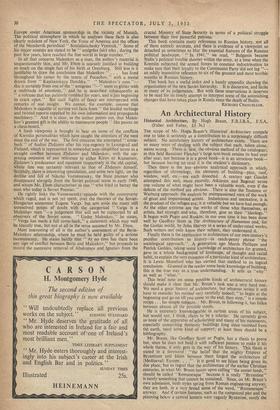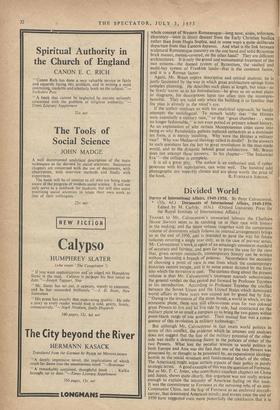An Architectural History
Historical Architecture. By Hugh Braun, F.R.I.B.A., F.S.A. (Faber and Faber. £3 3s.) THE scope of Mr. Hugh; Braun's Historical Architecture compels one to take it seriously as a contribution to a surprisingly difficult subject. No satisfactory history of architecture exists. There are so many ways of dealing with the subject that each, taken alone, seems wrong. There is, first, the obvious method of the cataloguer; in this field Bannister Fletcher's large text-book retains its lead year after year, not because it is a good book—it is an atrocious book— but because having no rival it is the student's dictionary. Then there is the less • obvious analytical approach in which, regardless of chronology, the elements of building—plan, roof, window, wall, etc.—are each dissected. . A century ago Guadet attempted this and, more recently, Atlunsbn and Bagenal wrote one volume of what might have been a valuable work, even if the defects of the method are obvious. There is also the Teutonic or Warburg approach: the analysis by unimpassioned men of the work of great and impassioned artists. Industrious and uncreative, it is the product of the refugee era; it is valuable but we have had enough. At the other extreme are the works of those who themselves, as artists, feel strongly and who, therefore, give us their "ideology." It began with Pugin and Ruskin; in our own time it has been done well by Geoffrey Scott in The Architecture of Humanism and, for the Gothic world, by John Harvey in a series of under-rated works. Such writers not only know their subject, they understand it.
Finally there is the application to architecture of our own century's peculiar contribution to history—in catch-penny phrase "the sociological approach." A generation ago March Phillipps and Patrick Geddes, taking some knowledge of architecture for granted, gave us a whole backgrouhd of landscape, of thought and racial habit, to explain the very existence of a particular kind of architecture. It is Lewis Mumford who has carried that method to its logical. conclusion. Granted in the reader some basic knowledge of building, this is the true way to a true understanding. It tells us "why" as well as "what."
This brief note on some possible kinds of architectural history should make it clear that Mr. Braun's task was a very hard one.. We need a great history of architecture, but whoever writes it will have to consider his method very carefully indeed; "to begin at the beginning and go on till you come to the end, then stop," is a simple recipe ... for simple subjects. Mr. Braun, in following it, has fallen between almost all the possible stools. He is extremely knowledgeable in certain areas of his subject, but would not, I think, claim to be a scholar. He certainly gives us none of the apparatus of scholarship and many of his statements, especially concerning domestic buildings long since vanished from the earth, need some kind of support; at least there should be a bibliography. Mr. Braun, like Geoffrey Scott or Pugin, has a thesis to prove but, since he does not hold it with sufficient passion to make it his whole theme, it only gets in the way of his history. This thesis is stated in a foreword : "the belief that the mighty Empires of Byzantium and Islam between them forged the architecture of [Mediaeval] Europe. . . ." It is good to see Islam being given its due place; but to regret that the architecture of the earlier Christian centuries, in what Mr. Braun insists upon calling "the sunset lands," should be called "Romanesque" because it is really "Byzantine" is surely something that cannot be sustained. Since, on Mr. Braun's own admission, both styles spring from Roman engineering anyway, they are both, in a very broad sense of the word, "Romanesque" anyway. And if certain features, such as the compound pier and the planning below a central lantern were vaguely Byzantine, surely the
whole concept of Western Romanesque—long nave, aisles, triforium, clearstory—were in direct descent from the Early Christian basilica rather than from Hagia Sophia, and in some ways a quite deliberate departure from that Eastern hypsosis. And what is the link between sculptural Romanesque masonry on the one hand and solid Byzantine brick masses, mosaic-covered, on the other hand? They are different architectures. It is only the grand and monumental treatment of the two systems—the domed system of Byzantium, the vaulted and multi-bay system of Frankish lands—that is the common factor, and it is a Roman factor.
Again, Mr. Braun enjoys descriptive and critical analysis; he is justly fascinated by the way in which great architecture springs from complex planning. He describes such plans at length, but since—as he firmly warns us in his Introduction—he gives us no actual plans or diagrams, his descriptions lapse too often into the incompre- hensible. They are valid only when the building is so familiar that the plan is already in the mind's eye.
If the author confuses us with his analytical approach, he barely attempts the sociological. To remark baldly that "the Hittites were essentially a military race," or that "great churches . . . were no longer fashionable," is not even potted or primary school history. As an explanation of why certain Mesopotamian cities came into being or why Renaissance palaces replaced cathedrals as a dominant art form, it is merely insulting. Why were the Hittites a military race? Why was Mediaeval theology called in doubt? In the answers to such questions lies the key to great revolutions in the man-made world, and to the dynamic behind great architecture. Mr. Braun does not attempt these answers. In his chapter—"The Industrial Era"—the collapse is complete.
It is all a great pity. The author is an enthusiast and, if rather generous with his superlatives, can write well. The hundred odd photographs are superbly chosen and are alone worth the price of the book.
R. FURNEAUX JORDAN.



























































 Previous page
Previous page